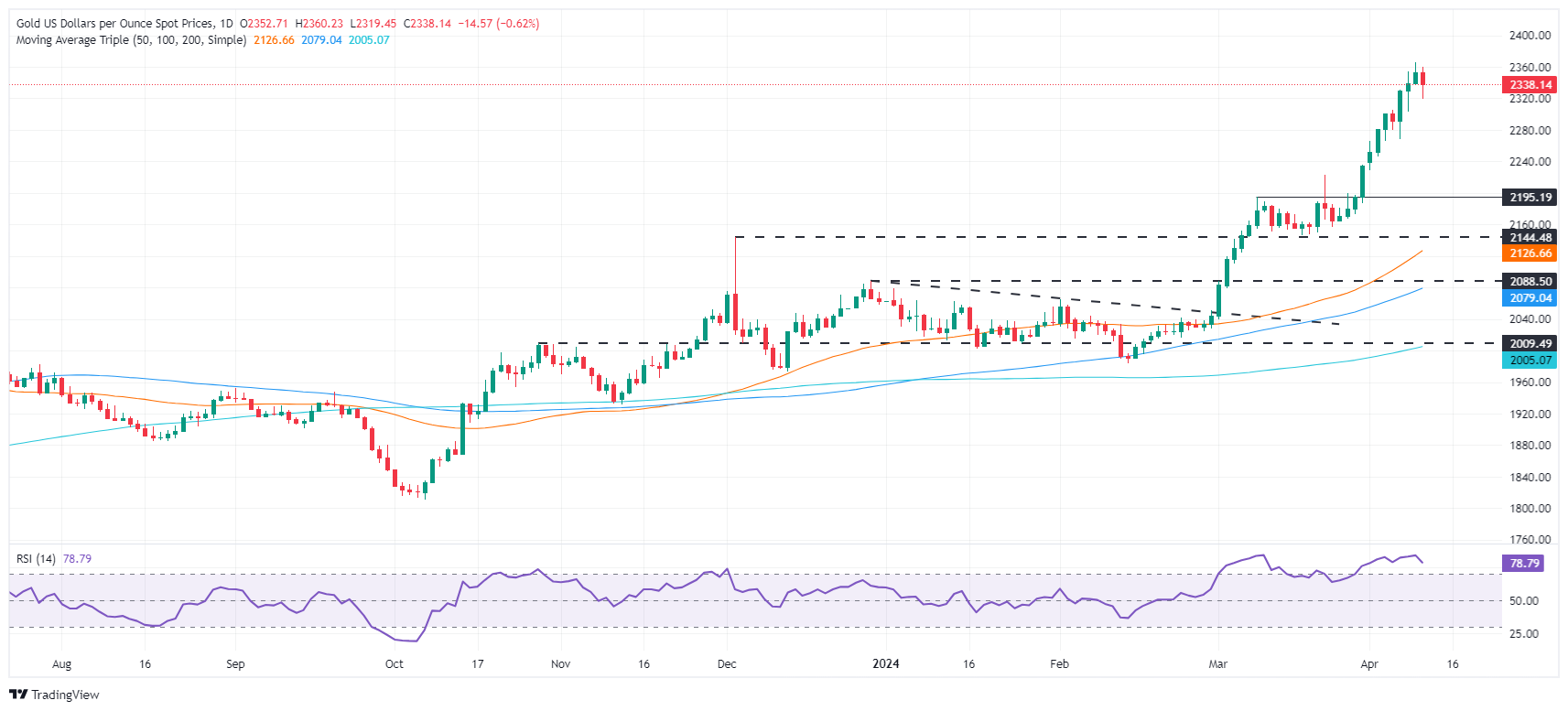- Gold drops as US inflation data complicates Fed rate cut intentions.
- Investors rethink Fed’s monetary approach amid persistent inflation as they now expect two rate cuts in 2024.
- US real yields rise above 2%, challenging Gold post-CPI release.
Gold price is on the defensive on Wednesday following the release of March inflation figures in the United States (US). The figures witnessed an uptick in monthly and annual readings and might dent the Federal Reserve’s (Fed) intentions of easing policy. Following the data release, US Treasury yields rose, the Greenback climbed, and US real yields overcame the 2% threshold, a headwind for the precious metal.
XAU/USD spot trades at $2,336 after losing 0.66% following the US Consumer Price Index (CPI) release. The US Bureau of Labor Statistics (BLS) announced that March’s CPI was hotter than expected, though unchanged in three of the four inflation readings compared to February’s data. Meanwhile, headline inflation jumped above the annual forecast and the prior month’s reading.
Daily digest market movers: Gold loses its shine after hot US CPI report
- US Consumer Price Index (CPI) increased 0.4% monthly and 3.5% annually, surpassing expectations and marking an uptick from the previous month’s figures.
- Core CPI, which excludes food and energy, also exceeded forecasts, remaining steady at 0.4% MoM and 3.8% YoY, mirroring February’s data.
- Following this, US Treasury bond yields experienced a significant surge, particularly at the short end, with the 2-year Treasury note yield jumping by 20 basis points.
- The US Dollar Index (DXY) also witnessed a substantial increase, soaring over 1% to reach new YTD high of 105.27.
- Data from the Chicago Board of Trade (CBOT) suggests that futures traders expect just two cuts to the fed funds rate as they project the main reference rate to end the year at 4.98%.
- World Gold Consortium reveals that the People’s Bank of China was the largest buyer of the yellow metal in February, increasing its reserves by 12 tonnes to 2,257 tonnes.
Technical analysis: Gold’s advance stalls, prices tumble below $2,350

Gold’s retreat from all-time highs opened the door to form an Evening Star candlestick pattern. However, XAU/USD must close below the April 8 open of $2,329, which would pave the way for a deeper correction.
The XAU/USD first support would be the April 8 daily low of $2,303. Once surpassed, that could put downward pressure on the yellow metal and drive it to March’s 21-session high of $2,222. Further losses are seen at $2,200.
On the other hand, if XAU/USD resumes its rally, buyers are eyeing the $2,350 mark, followed by $2,400.
Inflation FAQs
Inflation measures the rise in the price of a representative basket of goods and services. Headline inflation is usually expressed as a percentage change on a month-on-month (MoM) and year-on-year (YoY) basis. Core inflation excludes more volatile elements such as food and fuel which can fluctuate because of geopolitical and seasonal factors. Core inflation is the figure economists focus on and is the level targeted by central banks, which are mandated to keep inflation at a manageable level, usually around 2%.
The Consumer Price Index (CPI) measures the change in prices of a basket of goods and services over a period of time. It is usually expressed as a percentage change on a month-on-month (MoM) and year-on-year (YoY) basis. Core CPI is the figure targeted by central banks as it excludes volatile food and fuel inputs. When Core CPI rises above 2% it usually results in higher interest rates and vice versa when it falls below 2%. Since higher interest rates are positive for a currency, higher inflation usually results in a stronger currency. The opposite is true when inflation falls.
Although it may seem counter-intuitive, high inflation in a country pushes up the value of its currency and vice versa for lower inflation. This is because the central bank will normally raise interest rates to combat the higher inflation, which attract more global capital inflows from investors looking for a lucrative place to park their money.
Formerly, Gold was the asset investors turned to in times of high inflation because it preserved its value, and whilst investors will often still buy Gold for its safe-haven properties in times of extreme market turmoil, this is not the case most of the time. This is because when inflation is high, central banks will put up interest rates to combat it. Higher interest rates are negative for Gold because they increase the opportunity-cost of holding Gold vis-a-vis an interest-bearing asset or placing the money in a cash deposit account. On the flipside, lower inflation tends to be positive for Gold as it brings interest rates down, making the bright metal a more viable investment alternative.

























